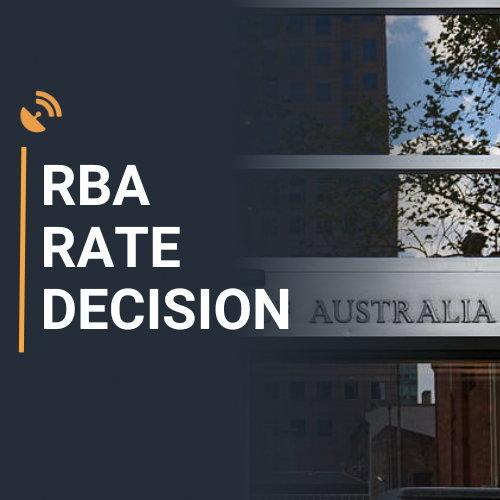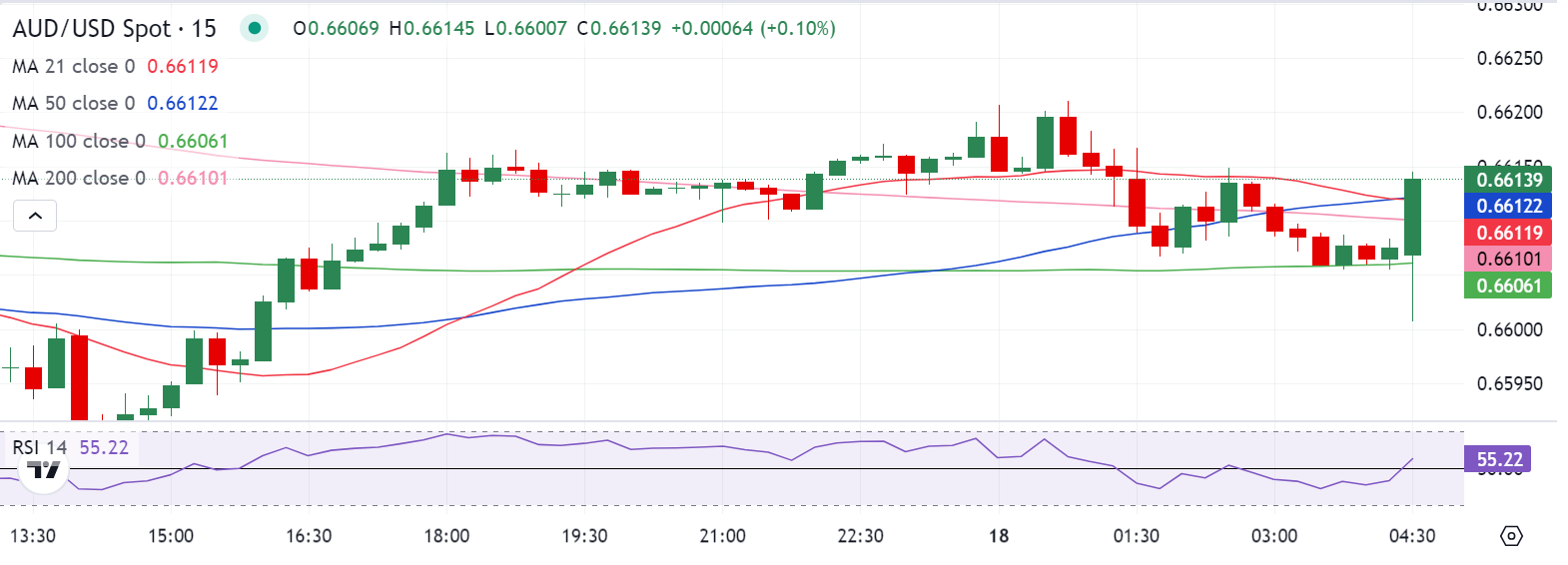Reserve Bank of Australia (RBA) Governor Michele Bullock is due to hold a press conference following the June monetary policy announcement.
Bullock will take questions from the press, as part of a new reporting format for the central bank starting this year.
At its June policy meeting, the RBA kept the policy rate unadjusted at 4.35% for the fifth meeting in a row. The central bank continued to remain non-committal on the next interest rate move.
Economic Indicator
RBA Press Conference
Following the Reserve Bank of Australia’s (RBA) economic policy decision, the Governor delivers a press conference explaining the monetary policy decision. The usual format is a roughly one-hour presser starting with prepared remarks and then opening to questions from the press. Hawkish comments tend to boost the Australian Dollar (AUD), while on the opposite, a dovish message tends to weaken it.
This section below was published at 04:30 GMT to cover the Reserve Bank of Australia’s monetary policy announcements and the initial market reaction.
Following the conclusion of its June policy meeting on Tuesday, the Reserve Bank of Australia (RBA) board members decided to keep the Official Cash Rate (OCR) unchanged at 4.35%.
The policy announcement matched the market expectations.
The RBA maintained the key rate for the fifth consecutive meeting in a row after a 25 basis points (bps) rate hike last November.
RBA’s Governor Michele Bullock presented the monetary policy statement, with the key takeaways noted below.
Board remains resolute in its determination to return inflation to target.
Inflation remains above target and is proving persistent.
Inflation is easing but has been doing so more slowly than previously expected and it remains high.
The board expects that it will be some time yet before inflation is sustainably in the target range.
The path of interest rates that will best ensure that inflation returns to target in a reasonable timeframe remains uncertain and the board is not ruling anything in or out.
The pace of decline has slowed in the most recent data, with inflation still some way above the midpoint oftarget range.
Wages growth appears to have peaked but is still above the level that can be sustained given trend productivity growth.
Conditions in the labor market eased further over the past month but remain tighter than is consistent with sustained full employment and inflation at target.
Since then, there have been indications that momentum in economic activity is weak, including slow growth in GDP, a rise in the unemployment rate and slower-than-expected wages. growth
AUD/USD reaction to the RBA interest rate decision
The Australian Dollar stays unfazed in an immediate reaction to the RBA’s extended pause. The AUD/USD pair is losing 0.07% on the day to trade near 0.6600.
AUD/USD: 15-minutes chart
Australian Dollar PRICE Today
The table below shows the percentage change of Australian Dollar (AUD) against listed major currencies today. Australian Dollar was the strongest against the New Zealand Dollar.
| USD | EUR | GBP | JPY | CAD | AUD | NZD | CHF | |
|---|---|---|---|---|---|---|---|---|
| USD | 0.11% | 0.07% | -0.02% | 0.11% | 0.02% | 0.25% | 0.00% | |
| EUR | -0.11% | -0.05% | -0.14% | 0.00% | -0.12% | 0.14% | -0.11% | |
| GBP | -0.07% | 0.05% | -0.10% | 0.05% | -0.05% | 0.20% | -0.07% | |
| JPY | 0.02% | 0.14% | 0.10% | 0.14% | 0.03% | 0.27% | 0.01% | |
| CAD | -0.11% | 0.00% | -0.05% | -0.14% | -0.10% | 0.12% | -0.11% | |
| AUD | -0.02% | 0.12% | 0.05% | -0.03% | 0.10% | 0.23% | -0.01% | |
| NZD | -0.25% | -0.14% | -0.20% | -0.27% | -0.12% | -0.23% | -0.25% | |
| CHF | -0.00% | 0.11% | 0.07% | -0.01% | 0.11% | 0.01% | 0.25% |
The heat map shows percentage changes of major currencies against each other. The base currency is picked from the left column, while the quote currency is picked from the top row. For example, if you pick the Australian Dollar from the left column and move along the horizontal line to the US Dollar, the percentage change displayed in the box will represent AUD (base)/USD (quote).
This section below was published on June 17 at 22:45 GMT as a preview of the Reserve Bank of Australia (RBA) policy announcements.
- Interest rate in Australia is set to stay steady at 4.35% for the fifth consecutive meeting in May.
- Reserve Bank of Australia Governor Michele Bullock will hold a press conference at 05:30 GMT.
- The Australian Dollar could see a big reaction to RBA’s policy statement and Bullock’s words.
The Reserve Bank of Australia (RBA) is unlikely to give into the pressure of a dovish policy pivot, as adopted by the Bank of Canada (BoC) and the European Central Bank (ECB) when it concludes its policy meeting on Tuesday.
The RBA is set to keep the Official Cash Rate (OCR) unchanged at 4.35% for the fifth meeting in a row in June. The decision will be announced at 04:30 GMT, while Governor Michele Bullock’s press conference will follow at 05:30 GMT.
Reserve Bank of Australia expected to extend the pause, but what’s next?
Economists are widely expecting the RBA to hold its borrowing rate at a 12-year high at yet another policy meeting, with Governor Michele Bullock likely to retain her hawkish rhetoric during the press conference.
In lieu of the stickier nature of inflation, the Australian central bank could leave the door ajar for a rate hike this year, especially after the Minutes of the RBA’s May meeting showed that the board members considered increasing interest rates.
However, the RBA could refrain from explicitly signaling a policy pivot in the upcoming meetings, maintaining a ‘higher rates for longer’ view.
The May policy statement read, “recent data have demonstrated that the process of returning inflation to target is unlikely to be smooth. Persistence of services inflation is a key uncertainty.”
Therefore, “not ruling anything in or out on future decisions,” the statement added.
The trimmed mean Consumer Price Index (CPI), the RBA’s measure of underlying inflation, ticked lower from 4.2% YoY to 4.0% year-over-year in the three months to March, but at a slower pace than expected. Meanwhile, The first quarter headline inflation rate was 1%, compared with the 0.6% pace in the December quarter. Economists had tipped it would rise to 0.8%. The main reason behind the slower-than-expected decline in inflation was the elevated services inflation alongside a tight labor market. This remains a major cause of concern for the central bank.
The recent labor market data published by the Australian Bureau of Statistics (ABS) showed that the Australian economy added 39,700 jobs in May, driven by full-time employment, compared to an expected 30,000 gain. The Unemployment Rate dipped to 4% in May from 4.1% in April.
Against this economic backdrop, the RBA is likely to remain in a wait-and-see mode until the release of the second quarter inflation data due on July 31. Another unwelcome surprise on the inflation front could warrant the RBA’s action.
Previewing the RBA policy decision, analysts at TD Securities (TDS) explained, “the Board is likely to reiterate that it “…will remain vigilant to upside risks.” However we are not expecting the Board to shift its tone, comfortable for now that a higher for longer cash rate will do its job of getting on top of inflation. The Bank has indicated it’s reluctant to ‘fine tune’ policy but if the Bank mentions Q2 CPI as a risk, this would be considered hawkish.”
How will the RBA interest rate decision impact AUD/USD?
Having faced rejection once again at the 0.6700 level, the Australian Dollar (AUD) has turned south against the US Dollar (USD). If RBA Governor Bullock explicitly signals a rate hike in the upcoming meetings this year, AUD/USD could see a fresh upswing toward the abovementioned key resistance.
On the other hand, AUD/USD could extend the ongoing downtrend to test 0.6500 on the RBA’s failure to affirm the hawkish expectations. Therefore, the language in the policy statement and Bullock’s comments are likely to determine the next directional move in the AUD/USD pair.
In the lead-up to the RBA showdown, big banks, including Australia and New Zealand Banking Group (ANZ) and Societe Generale, have pushed back the likely timing of the RBA’s first interest rate cut to early 2025 from November this year.
Dhwani Mehta, Asian Session Lead Analyst at FXStreet, notes key technicals to trade AUD/USD on the policy outcome. “AUD/USD is on track to challenge a critical demand area near 0.6650, where the 100-day and 200-day Simple Moving Averages (SMA) hang around. The 14-day Relative Strength Index (RSI) points lower below the 50 level, indicating a clear downside path for the pair heading into the RBA interest rate decision.”
“Aussie buyers need to defend the abovementioned key support near 0.6550 on a daily closing basis to attempt a rebound toward the 21-day SMA at 0.6635. The next upside barrier is seen at the critical 0.6700 threshold. Conversely, a downside break of the 0.6550 support zone could trigger a fresh downtrend toward the 0.6500 level. The last line of defense for buyers is seen at 0.6477, the March 5 low,” Dhwani adds.

